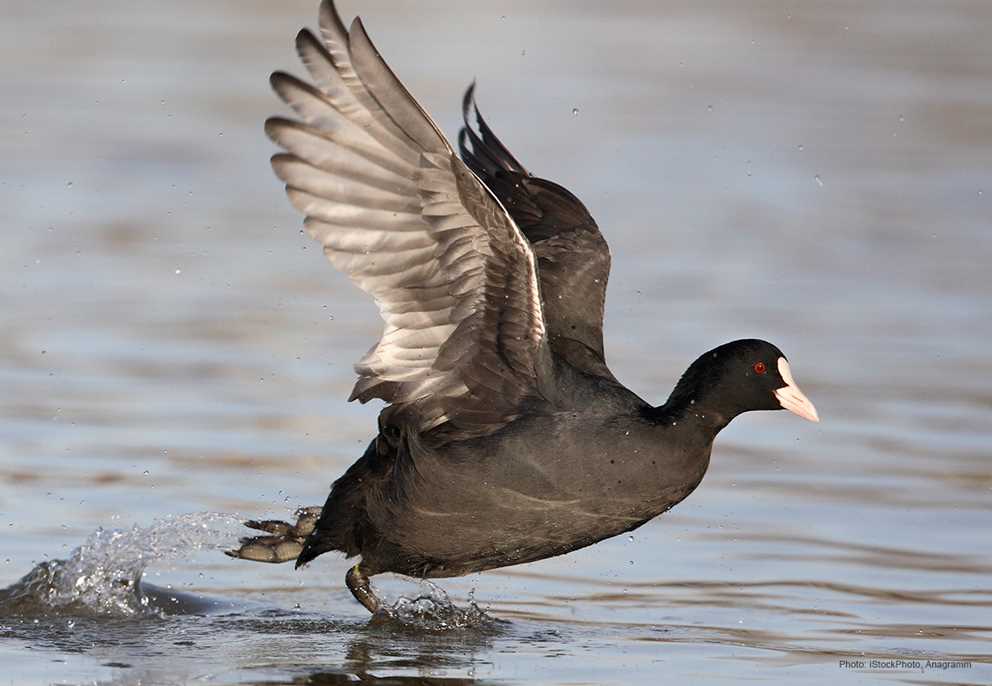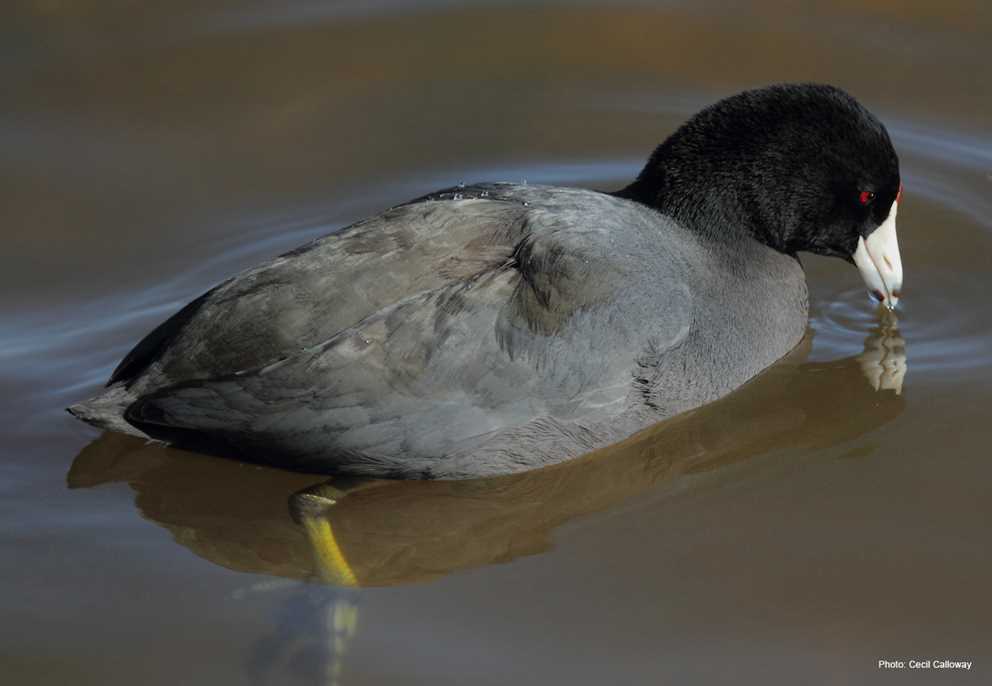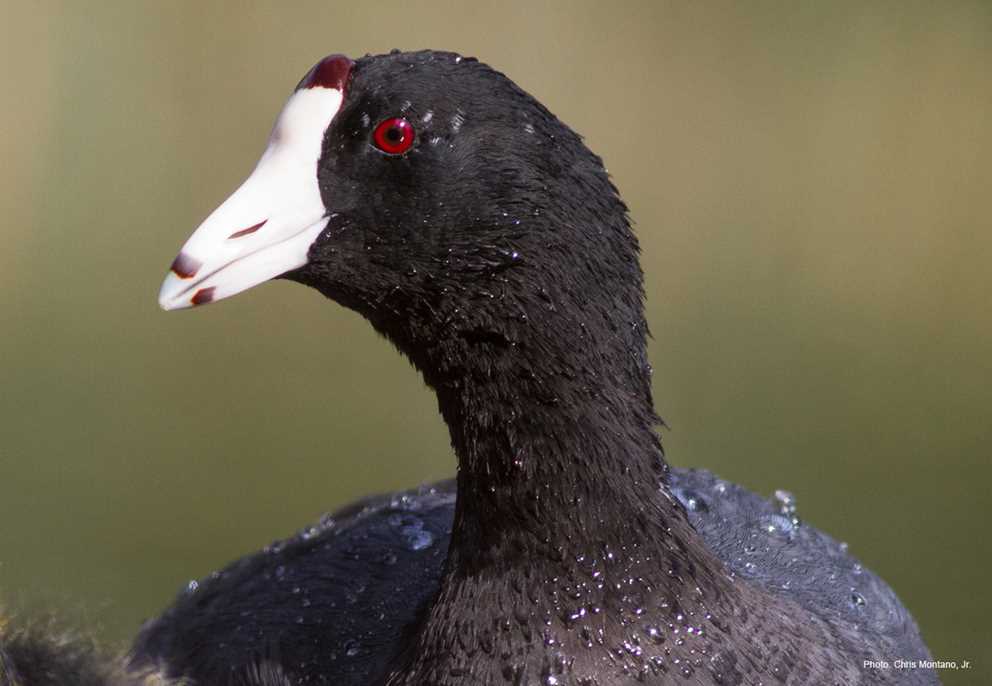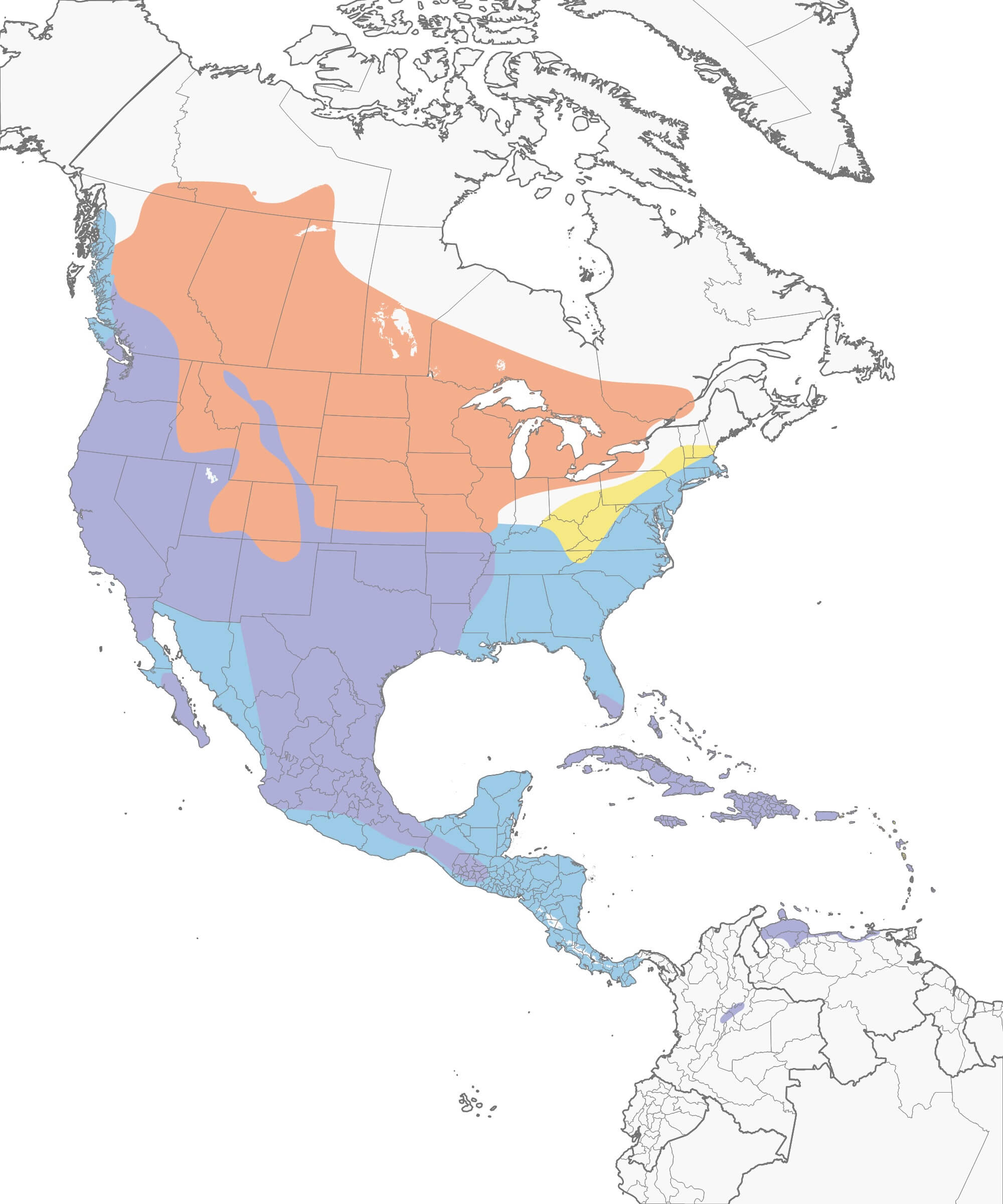Overview
The American Coot is a common wetland bird in the rail family (Rallidae). It is the most abundant, widely distributed species of rail, found in many wetland systems and types across North America. The core breeding range of the migratory population is in the Prairie Pothole Region, but some breed as far north as the southern portions of the Northwest Territories, extending south to a line from Utah to Missouri. Resident populations are found in the western and south-central United States, extending southward into Mexico. The winter range is like that of the resident population but extends southward to about Panama.
American Coots are dark gray to black, chicken-like, with a distinctive white bill with dark spots near the tip, and a frontal shield with a reddish spot near the top, and red iris. The feet are lobed and range in color from green to greenish-gray. They prefer freshwater wetlands, lakes, marshes, and wastewater impoundments, but may also be found in coastal marine wetlands in winter. They may form large rafts numbering in the thousands in winter.
Description
Key Identification Features
- American Coots are dark gray to black, chicken-like, with a distinctive white bill with dark spots near the tip, and a frontal shield with a reddish spot near the top, and red iris. The feet are lobed and green to green-gray in color.
Male/Female Average Length and Weight
- Weight: Males 1.3–1.9 lbs.; Females 0.9–1.4 lbs.
- Total Length: 15 in.
Male and Female Identification
- Alternate (Breeding) and Basic Plumage: Plumages are similar, and similar between sexes. American Coots are dark gray to black, chicken-like, with a distinctive white bill with dark spots near the tip, and a frontal shield with a reddish spot near the top, and red iris. The feet are lobed and range in color from green to green-gray.
Vocalizations
- Very vocal, may give grunting, croaking, or squawking calls.
Similar Species
- American Coots are unique and not likely to be confused with any other bird in North America. Could possibly be confused with Common Gallinules, which are lighter gray and have a red bill with a yellow tip and red frontal shield, and horizontal white linear markings on the sides.
Habitat Preferences
- Breeding: American Coots use a wide range of freshwater habitats usually characterized by dense emergent vegetation along margins of wetlands, and wetlands that are flooded for at least the duration of the breeding and brood-rearing season (April through July).
- Migration and Wintering: American Coots use a wide variety of mostly freshwater wetlands, and occasionally coastal brackish marshes. Preferred wetlands often have abundant aquatic vegetation, a preferred food item of American Coots.
Foraging Habits and Diet
- American Coots predominantly eat plant material, especially aquatic plants like pondweed (Potamogeton sp., Najas sp., Ruppia sp.) and sedges (Eleocharis sp., Scirpus sp., Carex sp.). They also eat seeds of wetland grasses, including wild and cultured rice. Animal matter is less common in the diet but may increase during the breeding season to support egg formation.
Breeding Habits
- Monogamy: American Coots are seasonally monogamous. Pair formation is usually in the spring in breeding areas. Nests are initiated soon after arrival on breeding areas, the timing of which varies with latitude but generally is in May. A single brood is produced annually, but they persistently renest after loss of nests to predators.
- Nest Location: Nests are platforms built of vegetation overwater or as floating mounds. They may build multiple nests prior to selecting one to be used for egg laying.
- Clutch Size: 8 to 12 eggs. The eggs are buff, pinkish, or buffish stone, sub-elliptical, and are 1.9 by 1.3 in. The incubation period is about 23 to 27 days, but note that hatching is asynchronous, with the first egg hatching about 3 to 4 days ahead of the last laid egg. Renesting frequency is high.
- American Coot hatchlings are precocial but often remain in the nest for up to 1 or 2 days. During this time, the yolk sac provides energy, and the delayed departure is likely related to the asynchronous hatching of eggs. Parents brood hatchlings prior to nest departure and for days after departure, and both parents also feed hatchlings until about two weeks of age.
Migration and Distribution
American Coot migration is described as complex, variable, and not well understood. Birds from the northern portions of the range, where wetlands are susceptible to freezing, migrate long to moderate distances in fall and spring. Birds at more southerly or westerly locations may only migrate during severe winter weather. Other birds at southerly locations of their range are apparently nonmigratory. Birds in the northern portion of the range migrate from August to November in the fall, and from February to April in the spring, with arrival in the breeding area in late April to May.
Conservation Status
- IUCN Status: Least Concern
- Population Status: The USFWS estimated a population of 3 million American Coots in 1999. Partners in Flight, a migratory bird conservation partnership in North America, estimated the population at 7.1 million birds. There is no specific survey for American Coots on breeding or wintering areas.
- Conservation Concerns: Habitat loss poses a potential challenge, but American Coots are more resilient than dabbling ducks due to their preference for semipermanent marshes, whereas dabbling ducks rely more on seasonal and temporary wetlands, which are at greater risk of loss.
- Conservation Focus: Conservation of wetlands in the Prairie Pothole Region, especially semipermanent wetlands, is important for breeding American Coots. The maintenance and management of wetland habitats in California, Florida, Louisiana, Texas, and Mexico are crucial for ensuring overwinter survival.
Harvest Information
- In the 2022–2023 hunting season, the total harvest of American Coots was estimated at 643,700 in the United States.
- Harvest in 2022–2023 in the Atlantic Flyway was 170,000, the Mississippi Flyway harvest was 261,500, the Central Flyway harvest was 32,600, and in the Pacific Flyway, it was 179,700. Harvest of American Coots is particularly important to hunters in Louisiana, where an estimated 188,000 were taken in 2022–2023.
- An additional 5,000–7,500 American Coots are harvested by hunters in Canada. American Coots are popular for subsistence harvest among some Indigenous peoples.





